On Sunday, January 11, as I have done on the equivalent
Sunday for three consecutive years, I flew from New
York LaGuardia Airport to Detroit
for the first day of events related to the annual North American International Auto Show. I took a taxi – the only really viable means of transport – to
downtown Detroit
for my first meeting. Then, lacking a bicycle – my preferred urban transport option - I started walking.
I walked from Greektown to the Rosa
Parks Transit
Center to catch a bus to Windsor , Ontario , where
my hotel was (there is, sadly, no way to walk across the Detroit River Windsor bus station to my hotel and back. I
walked from the Rosa Parks Transit
Center to Detroit ’s eastern market. I walked a mile
back to Greektown and then I walked back to the Rosa Parks Transit Center
I walked because I dislike being cooped up in cars and paying
for taxis. I prefer to get some exercise and see cities on a human level. But an
incident part way through the evening reminded me that walking can be a radical
– almost political – act, just as cycling is in some circumstances. In cities
that have been set up to suit only motor vehicles, someone who walks sets an
example of how it’s possible to break established patterns. Each pedestrian on
a once-deserted street helps to prove it can be safe to abandon the cocoon of a
motor vehicle.
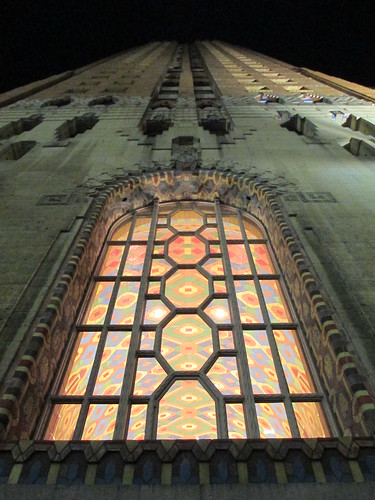 |
| Detroit's magnificent, art deco Guardian Building: the kind of detail it's worth taking a risk to see. |
Yet many of the people I meet when I go to Detroit think I’m simply inviting a mugging
or other violent crime by wandering through “dangerous” areas. Some of them, I
suspect, would be far from sympathetic if my foolishness led to my being hurt
or killed.
It’s an issue that resonates well beyond Detroit . On December 20, it emerged last
week, police in Montgomery County, Maryland, forcibly picked up two children –
Rafi Meitiv, 10, and Dvora Meitiv, six – whom their parents had allowed to walk
home from a park a mile away. The local government’s child services division is
investigating the parents for neglect. The numbers of children walking or
cycling to and from school in the UK have plummeted.
The walk from the bus station to Eastern Market helped to
remind me why walking remains a minority activity in many cities like Detroit . I walked on
sidewalks that were in poor repair and closed in places. I passed whole blocks
of empty, brownfield space. The motorists using the roads across these
wastelands were driving at grossly excessive speeds that made crossing the road
an uncomfortable experience. Although most of the sidewalks had been cleared of
the recent snow, not all had.
A considerable part of the walk was blighted by the presence
in the area of a vast cloverleaf interchange between the I-375 Interstate and
the Fisher Freeway. I walked on bridges over each, noting how, as some of Robert Moses' roads did in Brooklyn, they had cut through formerly coherent, walkable communities. Other streets
were effectively slip roads for the freeways, with vehicles driving at
commensurate speeds. The walk was also, thanks to Detroit ’s low-density, sprawling geography, a
mile-and-a-half, even though the areas looked close to each other on the city
map.
I nevertheless arrived safely and in good time for the event
I was planning to cover – the unveiling of some new models by General Motors’
Buick brand. I had the chance along the way to appreciate the fine architecture
of Trinity Lutheran Church Gratiot Avenue of how this neighbourhood must once have thrived . I was able to marvel at
the resilience of the Busy Bee hardware store at the corner of Gratiot and
Russell, still standing and serving customers when much of the surrounding area
was derelict. I was able to appreciate the skyline – a mixture of modern
attempts and redevelopment and art deco from the city’s early 20th
century heyday. I spotted how close my next appointment – with Volkswagen in
Greektown – appeared to be. I resolved to walk there too.
That resolve remained when I got a call from a colleague who
had been at another event and was being driven by its courtesy shuttle service to
Volkswagen. “Can my driver stop by and pick you up?” he asked. It was fine, I
replied – I would walk. My phone buzzed a few minutes later with a text
message. “Driver insisting we pick u up – safety an issue,” it read. My head
started whirling with the implications of what my colleague was saying, that
the driver was implying my behaviour was so foolish I should be given no choice
about persisting in it. “Tell him I walked here,” I texted back. I started on
what turned out to be a long search for my coat, for which I’d lost my coatcheck
ticket.
I considered, of course, the crime risks – the ones to which
my colleague’s driver was referring. It’s undoubtedly true that the Motor City Detroit ,
with a population of 700,000, in 2013 recorded 316 murders. That’s only just
short of the 334 recorded that year in New
York , which has a population of 8.4m. I kept my
iPhone mostly hidden as I walked, recognising it was one of the most obviously
stealable items in my possession. I kept my eyes wide open for any suspicious
activity.
But warnings against walking in Detroit don’t often feel to me based on
careful calculation of the crime risks in any given area. I once had an alarmed
auto company executive offer to find me a hotel room somewhere other than
touristy Greektown because she presumed the area so unsafe. The warnings tend
to come disproportionately from white residents of Detroit ’s outer suburbs who never venture
into the city proper outside a motor vehicle. Many people’s fears seem to
reflect the high numbers of homeless people panhandling for money in some
areas. I had one such person shout at me as I walked from the bus station to
the Eastern Market. But, while I’ve sometimes had such panhandlers follow me
for considerable distances, I’ve never felt seriously in danger.
It is certainly not comfortable to encounter the myriad
social problems from which Detroit
– which is mainly poor, 85 per cent black and whose city government has only
just emerged from bankruptcy - suffers. “It’s because of you I caught my domestic
violence conviction!” I heard a man shouting into his iPhone one night at the Rosa Parks
Transit Center
There is no doubt at all, meanwhile, that the thinking that
constrains the lives of children like the Meitivs is seriously flawed. Parents
typically give far less freedom of movement to children than 40 years ago, yet
rates of crime against children are far lower than they were then.
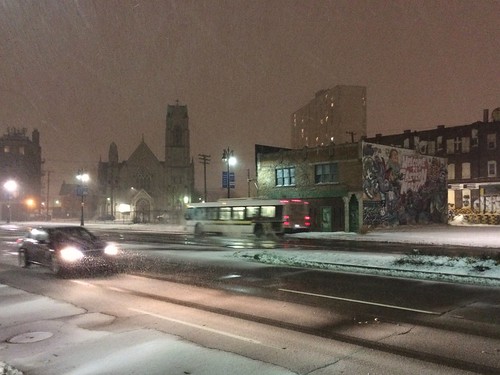 |
| Gratiot Avenue in the snow: my colleague's driver understood none of why I was prepared to walk in these conditions. The empty sidewalks show how many people share his opinion. |
It consequently felt like almost a moral imperative when the
driver said I shouldn’t be walking to prove that it was indeed possible to do
so. Having finally located my coat, I strode purposefully towards the exit. I
kept striding even once I’d discovered, to my mild consternation, that it had
started snowing steadily while I was inside. I was soon on my way back down Gratiot Avenue ,
face buried in my collar against the wind, towards the Volkswagen press event.
Later that evening, my colleague and I both walked to the bus stop by the
entrance to the cross-border tunnel. On the way, we saw almost no-one outside a
motor vehicle. The walking felt mundane, rather than risk-laden.
In the days since, however, the experience of getting around
Detroit and Windsor by bus and on foot has played on my
mind. I’ve been considering it particularly over the past weekend, which
includes a holiday to remember Martin Luther King, jr, the civil rights leader.
In that context, the name of Detroit ’s central
bus station – the Rosa
Parks Transit
Center Detroit – who drew Dr King into the
civil rights movement through her famous refusal to give up her seat on a bus
in Montgomery , Alabama
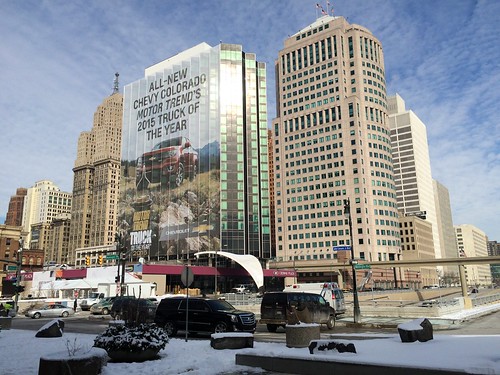 |
| Downtown Detroit in auto show week: it looks smart - but what would Martin Luther King make of the way its people get about? |
The battle over shared space on buses that Ms Parks set off
was possible, it occurs to me, only because black and white people in Montgomery were indeed
sharing space on public transport. Such a struggle is unthinkable in
contemporary Detroit
largely because white and black people so seldom share space when getting
about. They are closeted either in private motor cars or on a bus system that
almost no whites use
It would be fatuous, of course, to claim that my stubborn
determination to walk a few times in Detroit
did anything to alter those dynamics. The risks of crime in the city are real
and substantially higher than in New York ,
which remains less safe on average than the UK . My stance will look less clever
if, one day, I find myself beaten to a pulp over my phone or laptop – or worse.
But, as I walked past lonely, derelict buildings, I imagined
how the now-abandoned stores must once have relied on passing foot traffic. The
scaring away of pedestrians after Detroit
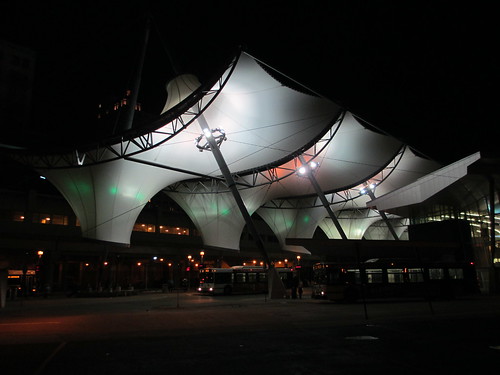

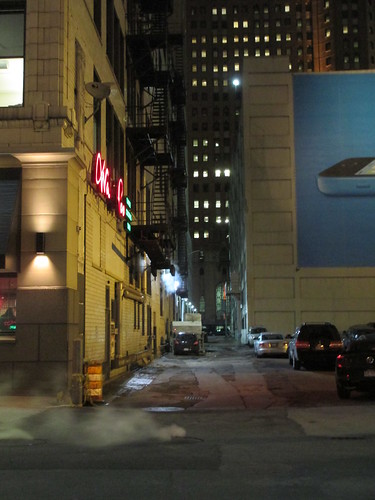
When we walk in the detroit suburbs I'm often struck by how many people there are on the sidewalks, but they're mostly 'exercising', not actually going anywhere. ...with a few exceptions.
ReplyDeleteBut last time I was downtown, i was amazed at how many bikes we saw - and that was 4 years ago, before the current 'boom'.
Sara,
DeleteThank you for the comment.
I imagine the position varies from suburb to suburb. In the last year, I've stayed in Troy, MI, and Warren, MI. Those are pretty bleak places - but I've seen runners in other places. The big problem, I suppose, is how substantial the distances are out in those areas. The nearest hotel to the General Motors Technical Center in Warren is about five miles away. That's the big problem with trying to improve public transit too - with so little density and such great distances, it's a real challenge.
I've seen cycling in parts of Detroit proper. I notice it more in midtown, where it feels a little less forbidding. But I did on my walk along Gratiot Avenue spot a few cyclists, including, if I recall correctly, one braving the snow.
All the best,
Invisible.
Sadly, it sounds a lot like New Orleans...
ReplyDeleteSteve,
DeleteFrom what I understand about New Orleans (and, hey, I've watched several seasons of Treme) I think New Orleans and Detroit probably have many points in common, including being highly segregated.
On the plus side, both have fine musical traditions. And New Orleans has a rather better food tradition than Detroit.
All the best,
Invisible.
Oddly, in my post later tonight, it seems that cars are keeping people "together" in New Orleans. It may take parking garages to get them back apart as an arterial bypass analog. As for the traditions, I don't think you'll find many street musicians outside in Detroit in January. To experience that, you'd have to fly into Louis Armstrong Airport.
DeleteI think the different densities of Detroit and New Orleans' French quarter probably make a big difference to how motor vehicles shape the two places, Steve.
DeleteAs for outdoor musicians, no, there aren't any in Detroit in January. There was, as there often is, a group of women miming to classic Motown inside the CoBo Center. One just had to suspend disbelief a little that one of them was white.
Thanks for your article. There is planning underway that may remove some or all of I-375 and improve the walkability/bikeability of that I-75 interchange. Also, some Detroit hotels offer bicycles for their guests, including Greektown. We expect to roll out a public bike share program next spring.
ReplyDeleteTodd,
DeleteThank you for that. I had wondered if some of those freeways were going to get removed. I also look forward to using bikeshare on future visits.
Unfortunately, however, on this trip, I was staying in Windsor for cost reasons, so a hotel bike wouldn't have been much good.
All the best,
Invisible.
Got it! That's all the more reason for us to continue the push for ferry service between Detroit and Windsor. That would make it easier to walk and bike between both cities. The last we heard there were dock infrastructure issues on the Windsor side.
ReplyDeleteAlternatively, I'm not crystal clear why they're not allowed to carry bikes on the front of buses through the tunnel. I know it's possible to hide a bomb in a bike - but there must be some way of making security checks.
DeleteInvisible.
It didn't have anything to do with security. Transit Windsor told us that their drivers are already concerned making some of the tighter curves on the U.S. side of the tunnel. Extending the bike rack makes the bus longer and the curves trickier. Right or wrong, we took their word for that. At a bus driver's discretion, you may be able to bring a bike on board so long as it doesn't roll around.
DeleteI can see, Todd, why the drivers might be concerned. The bends at the US end of the tunnel are tight. I imagine anything that lengthens the bus at those points could be unwelcome.
DeleteAll the best,
Invisible.
Sounds like you'd like "Walk Rabbit Walk" by Colin McNaughton and Elizabeth Attenborough. It's the story of a rabbit who likes to walk, so he goes on a walk to visit his friend Eagle who has invited all of his friends to a party. Along the way, Rabbit's friends offer him a ride in their car/motorcycle/helicopter/balloon, but Rabbit politely refuses each time. In the end, the friends get into a pile-up and Rabbit ends up being the first to arrive at the party!
ReplyDeleteThat book does sound good, Anonymous. But is it aimed at men in their mid-40s?
DeleteHaving said that, I fear the book wouldn't be a good influence on me. I'm forever insisting I'll get somewhere just as fast or faster than others when I go by bike. And then the other people get fed up waiting for me when their taxi/subway train/ pretty much anything gets them there faster.
All the best,
Invisible.
It's a children's book, but one is never too old for a good story! :-) I have a copy of it since I was a child, and now I've read it to my children.
DeleteOne of Rabbit's main reasons to prefer to walk is that he doesn't want to miss the nice little details along the way. That's why I thought you'd empathize with the character.
You are right, Anonymous, that I sympathise heartily with rabbit's determination to miss none of the details along the way.
DeleteInvisible.
I can really relate to this: "... the driver was implying my behaviour was so foolish I should be given no choice about persisting in it."
ReplyDeleteSeveral years ago, I had ridden my bike to a weekly evening class at a community center about 6 miles from home. At the end of the class it was pouring rain, and a couple of people informed me that I couldn't possibly ride my bike home in this weather and would have to accept a ride in someone's car. I explained that I planned to wait inside for half an hour and give the weather a chance to improve, and if it remained horrible I would get in touch with my husband to come get me on his way home from another event with our car. It seemed reasonable enough to me, but when I didn't instantly agree to their plan, the stakes were raised-- while I made a phone call, the most alarmed person hid my purse to prevent me from being able to leave. An unpleasant scene or two later, I had my bag back and everyone else left. A few minutes after that, I noticed the rain had stopped and had a quiet ride home. True, it did start raining again along the way, but that wasn't a disaster, just a mild inconvenience.
When I thought about it afterwards it seemed to me that in the eyes of these well-meaning people, I had given up being a responsible adult when I opted to use my bike for transportation, and so it was up to them to protect me from the consequences of my foolish and dangerous choices.
QMacrocarpa,
DeleteThat's a really unpleasant story. People really don't understand that one can have thought about the risks and rewards of a set of behaviour and have reached a different conclusion from them.
All the best,
Invisible.
Back in the 1960s and 1970s kids were always routinely walking around their neighborhoods either by themselves or with their friends, going by themselves to the zoo, or the park, or to a friend's house.
ReplyDeleteThe biggest dangers usually came either from the neighborhood bullies or from the occasional car-pedestrian accidents. Such were norms even back then.
Tal,
DeleteThanks for the comment.
I think statistics would suggest that life was markedly more dangerous back in the 1970s. I even wrote recently about how I was knocked down in 1980 and how the site has been improved since ( http://invisiblevisibleman.blogspot.com/2014/11/a-1980-crash-rushed-hearing-and-why.html ). General crime - including abductions - was worse then. The roads were also more dangerous.
The point is that people's willingness to put up with the risks of freedom has declined, even as the risks have grown smaller.
All the best,
Invisible.
Thx for post on Detroit from walking perspective. Glad you did the walk..
ReplyDeleteThank you. I'm glad too.
Delete